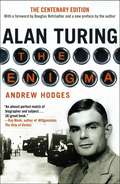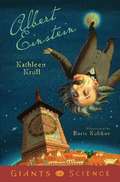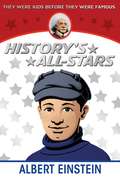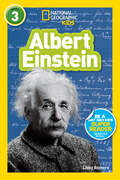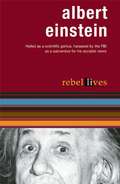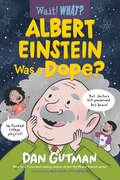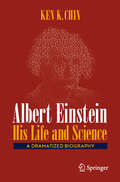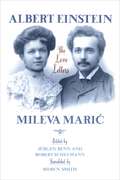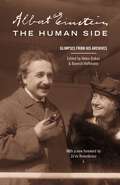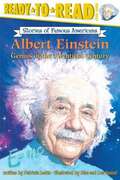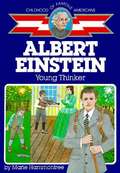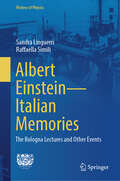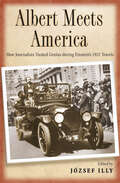- Table View
- List View
Alan Turing: The Enigma (The Centenary Edition)
by Andrew HodgesIt is only a slight exaggeration to say that the British mathematician Alan Turing (1912-1954) saved the Allies from the Nazis, invented the computer and artificial intelligence, and anticipated gay liberation by decades--all before his suicide at age forty-one. This classic biography of the founder of computer science, reissued on the centenary of his birth with a substantial new preface by the author, is the definitive account of an extraordinary mind and life. A gripping story of mathematics, computers, cryptography, and homosexual persecution, Andrew Hodges's acclaimed book captures both the inner and outer drama of Turing's life. Hodges tells how Turing's revolutionary idea of 1936--the concept of a universal machine--laid the foundation for the modern computer and how Turing brought the idea to practical realization in 1945 with his electronic design. The book also tells how this work was directly related to Turing's leading role in breaking the German Enigma ciphers during World War II, a scientific triumph that was critical to Allied victory in the Atlantic. At the same time, this is the tragic story of a man who, despite his wartime service, was eventually arrested, stripped of his security clearance, and forced to undergo a humiliating treatment program--all for trying to live honestly in a society that defined homosexuality as a crime.
Alaska Dinosaurs: An Ancient Arctic World
by Anthony R. FiorilloAnthony Fiorillo has been exploring the Arctic since 1998. For him, like many others, the Arctic holds the romance of uncharted territory, extreme conditions, and the inevitable epic challenges that arise. For Fiorillo, however, the Arctic also holds the secrets of the history of life on Earth, and its fossils bring him back field season after field season in pursuit of improving human understanding of ancient history. His studies of the rocks and fossils of the Arctic shed light on a world that once was, and provide insight into what might be.
Alaska's Animals, You And I
by Shannon CartwrightAlaska's Animals shows how various animals are different, comparing things like noses, feet, tails and dwellings with colorful, detailed and clever close-up compositions. All illustrations are accompanied by Shannon Cartwright's lyrical verses that roll.
Albert Einstein
by Kathleen Krull Boris KulikovAlbert Einstein. His name has become a synonym for genius. His wild case of bedhead and playful sense of humor made him a media superstar?the first, maybe only, scientist-celebrity. He wasn?t much for lab work; in fact he had a tendency to blow up experiments. What he liked to do was think, not in words but in ?thought pictures.? What was the result of all his thinking? Nothing less than the overturning of Newtonian physics. Once again, Kathleen Krull delivers a witty and astute look at one of the true ?Giants of Science? and the turbulent times in which he lived.
Albert Einstein
by Frieda WishinskyDKY's acclaimed DK Biography series tackles two of history's most colorful figures in Harry Houdini and Albert Einstein. Perfect for book reports or summer reading, the DK Biography series brings a new clarity and narrative voice to history's most colorful figures.
Albert Einstein
by Marie Hammontree Robert DoremusBefore Albert Einstein was an internationally renowned genius, he was a kid--learn all about his childhood and what makes him an all-star in American history!Albert Einstein is a household name synonymous with genius around the world. His work unlocked mysteries of the universe and also impacted everyday conveniences like remote controls and televisions. And while most are familiar with Einstein's adult wisdom (and wild hair), do you know what he was like as a child? From his passion for music--he played both the violin and the piano--to his early curiosity for understanding the mysteries of science, in this narrative biography you'll learn all about Albert Einstein's childhood and the influences that shaped the life of a remarkable man.
Albert Einstein (Basic Biographies)
by Susan KesselringA very simple introduction to the life and accomplishments of noted physicist Albert Einstein.
Albert Einstein (National Geographic Kids Readers)
by Libby RomeroExplore one of the most recognized scientists in the world with this biography of physicist Albert Einstein. Kids will learn about his life, achievements, and the challenges he faced along the way. The level 3 text provides accessible, yet wide-ranging, information for independent readers.
Albert Einstein (Rebel Lives)
by Albert Einstein Tom KeebleEinstein as an absent-minded genius with his head in the clouds is a far cry from the real picture. A man deeply interested in social issues, Einstein felt it was his duty to use his fame and intellect to advance the cause of social justice.
Albert Einstein Was a Dope? (Wait! What? #0)
by Dan GutmanFrom the best-selling author behind My Weird School: a quirky new biography series that casts fresh light on high-interest historic figures. Did you know that Albert Einstein was a high school dropout, and that he failed his physics class when he finally made it to college? Or that when he died, his brain and eyeballs were removed from his body? Ever wondered why his hair looked so wild? Siblings Paige and Turner do—and they’ve collected some of the kookiest and most unusual facts about the world-famous scientist, from his childhood and school days through his time studying relativity and working on the atomic bomb. Narrated by the two spirited siblings and animated by Allison Steinfeld’s upbeat illustrations, Albert Einstein Was a Dope? expertly balances authoritative information with Dan Gutman’s signature zany humor.
Albert Einstein and Relativity for Kids: His Life and Ideas with 21 Activities and Thought Experiments (For Kids series)
by Jerome PohlenBest known for his general theory of relativity and the famous equation linking mass and energy, E = mc², Albert Einstein had a lasting impact on the world of science, the extent of which is illuminated--along with his fascinating life and unique personality--in this lively history. In addition to learning all about Einstein's important contributions to science, from proving the existence and size of atoms and launching the field of quantum mechanics to creating models of the universe that led to the discovery of black holes and the big bang theory, young physicists will participate in activities and thought experiments to bring his theories and ideas to life. Such activities include using dominoes to model a nuclear chain reaction, replicating the expanding universe in a microwave oven, creating blue skies and red sunsets in a soda bottle, and calculating the speed of light using a melted chocolate bar. Suggestions for further study, a time line, and sidebars on the work of other physicists of the day make this an incredibly accessible resource for inquisitive children.
Albert Einstein and the Theory of Relativity
by Robert CwiklikEinstein's astonishing theory of relativity transformed every aspect of physics-from the study of atoms to the study of stars. Relativity is described here in simple, accurate language that young readers can comprehend. From the back cover Written to challenge the imaginations of young readers, ages 12-13, Barron's exciting Solutions Series presents dramatic stories of brilliant scientists and their discoveries that have changed our civilization. The excitement of scientific challenge and the thrill of the solutions found by men and women of science make stories that will inspire and entertain youthful readers. Teachers will also value these volumes for their supplementary aids, including glossaries and topic lists for essays.
Albert Einstein – His Life and Science: A Dramatized Biography
by Ken K. ChinThis book is part biographical account, part novel, and part popular science. The basic facts are historically true, but many episodes have additionally been dramatized with plausible content that brings the personal story to life in the style of a novel or movie script. This genre of a “dramatized biography" of scientists was first created by the author 45 years ago and became a great success selling over half a million copies in China, where it has been in particular demand for teaching. But this is not the whole story: In addition, the book explains, in a serious yet accessible manner, the basics of Einstein’s scientific work, especially its impact on contemporary cosmology, astronomy, and physics. As an experienced teacher of relativity and astronomy for high-school and university students, the author knows how to make profound scientific subjects accessible, and his presentation is as fascinating as a detective story. Readers will learn not only about the historical setting but also about the challenges and frustrations faced by Einstein, about his breakthroughs and triumphs, as well as the far-reaching significance of his theory of relativity, quantum mechanics, and other scientific achievements. The reader will come to understand why, of all the billions of people living in the twentieth century, Albert Einstein was singled out as the “Person of the Century.”
Albert Einstein, Boris Podolsky, Nathan Rosen: Can Quantum-Mechanical Description of Physical Reality Be Considered Complete? (Classic Texts in the Sciences)
by Claus KieferThe work published by Einstein, Podolsky and Rosen (EPR) in 1935 is a classic in modern physics. It discusses, for the first time, the central feature of the quantum theory: entanglement. In general, systems are intertwined with each other in nature; that is, they have only one common, non-divisible state. This fact is responsible for all the oddities commonly associated with quantum theory, including the famous thought experiments with Schrödinger’s cat and Wigner’s friend. The entanglement of quantum mechanics plays a central role in experiments with atoms and photons (Nobel Prize 2012 for Haroche and Wineland) and the planned construction of quantum computers. This book presents EPR’s original work amplified with a detailed commentary, which examines both the historical context and all aspects of entanglement. In particular, it focuses on the interpretation of quantum theory and its consequences for a basic understanding of nature.
Albert Einstein, Mileva Maric: The Love Letters
by Albert EinsteinIn 1903, despite the vehement objections of his parents, Albert Einstein married Mileva Maric, the companion, colleague, and confidante whose influence on his most creative years has given rise to much speculation. Beginning in 1897, after Einstein and Maric met as students at the Swiss Federal Polytechnic, and ending shortly after their marriage, these fifty-four love letters offer a rare glimpse into Einstein's relationship with his first wife while shedding light on his intellectual development in the period before the annus mirabilis of 1905. Unlike the picture of Einstein the lone, isolated thinker of Princeton, he appears here both as the burgeoning enfant terrible of science and as an amorous young man beset, along with his fiance, by financial and personal struggles--among them the illegitimate birth of their daughter, whose existence is known only by these letters. Describing his conflicts with professors and other scientists, his arguments with his mother over Maric, and his difficulty obtaining an academic position after graduation, the letters enable us to reconstruct the youthful Einstein with an unprecedented immediacy. His love for Maric, whom he describes as "a creature who is my equal, and who is as strong and independent as I am," brings forth his serious as well as playful, often theatrical nature. After their marriage, however, Maric becomes less his intellectual companion, and, failing to acquire a teaching certificate, she subordinates her professional goals to his. In the final letters Einstein has obtained a position at the Swiss Patent Office and mentions their daughter one last time to his wife in Hungary, where she is assumed to have placed the girl in the care of relatives. Informative, entertaining, and often very moving, this collection of letters captures for scientists and general readers alike a little known yet crucial period in Einstein's life.
Albert Einstein, The Human Side: Glimpses from His Archives
by Albert EinsteinModesty, humor, compassion, and wisdom are the traits most evident in this illuminating selection of personal papers from the Albert Einstein Archives. The illustrious physicist wrote as thoughtfully to an Ohio fifth-grader, distressed by her discovery that scientists classify humans as animals, as to a Colorado banker who asked whether Einstein believed in a personal God. Witty rhymes, an exchange with Queen Elizabeth of Belgium about fine music, and expressions of his devotion to Zionism are but some of the highlights found in this warm and enriching book.
Albert Einstein: Albert Einstein (I Am #2)
by Grace NorwichMeet the scientist who changed the way we think about the universe!I am one of the most gifted minds that ever lived. I am a Nobel Prize–winning physicist. I was expelled from school as a young child. I am Albert Einstein.Learn all about this brilliant man whose scientific accomplishments are truly remarkable in this biography featuring:illustrations throughouta timelinean introduction to the other people you’ll meet in the bookmapssidebarsa top ten list of important things to know, and more
Albert Einstein: Genius Of The Twentieth Century (Ready-to-Read Sofa)
by Patricia LakinFrom a young age Albert Einstein was curious and very smart. But that didn't mean life was easy for him. In fact, being so smart sometimes made things harder for him! Read all about his life, and find out why Albert Einstein is known as the genius of the twentieth century.
Albert Einstein: Great Scientist
by Anne Marie SullivanAs a child, Albert Einstein was quiet and awkward. He had trouble making friends and problems with learning in the classroom. As Albert grew up, he began to use his mind in ways he didn't learn in school, leading him to become an expert in math and science. Einstein's ideas helped change the way scientists thought of the world around us and change the course of history in the atomic age. Today, Einstein is one of history's most famous scientists, and his theories have shaped science for decades. Learn about one of the most important scientists of all time in Albert Einstein: Great Scientist.
Albert Einstein: Young Thinker (Childhood of Famous Americans Series)
by Marie HammontreeAll children know who Albert Einstein grew up to be--but what was he like as a child? A fictionalized biography of the childhood of the famous scientist.
Albert Einstein: pocket GIANTS
by Andrew MayEveryone has heard of Albert Einstein and everyone knows that he was a genius. Yet only a few people understand his work. In fact, he was just one of many brilliant scientists grappling with the deepest problems of theoretical physics during the first half of the twentieth century. He may not have been the most important or influential of them – the point is arguable – but there is no doubt he was the most revolutionary. Almost single-handed, he transformed the way the world thinks about light, matter, space and time.In the sixty years since his death Einstein has become a legend. The profound obscurity of his theories has contributed to this, as has his archetypal “mad scientist” appearance. His philosophical and political utterances – both real and imagined – are regularly used to clinch arguments online or in the pub. So how can a modern reader separate myth from reality? This short book attempts to do just that!
Albert Einstein—Italian Memories: The Bologna Lectures and Other Events (History of Physics)
by Sandra Linguerri Raffaella Simili (deceased)This book is dedicated to Einstein’s personal and scientific relationships with Italy, which began as early as adolescence and continued over various stages of his life. It collects together a wealth of historical documentation including the letters in which Einstein recalls having lived as a young man with his family in Lombardy, Pavia and Milan; the texts of three lectures delivered by Einstein in Italian in October 1921 in Bologna at the invitation of the mathematician Federigo Enriques, the only lectures he held in Italy; the correspondence with Enriques and other Italian intellectuals, together with the letter that Einstein sent in 1931 to the Minister of Justice Alfredo Rocco to try to avoid the infamy of the oath of allegiance to the fascist regime imposed by Mussolini on university professors. The book closes with some writings on relativity from 1907 to 1914 (Einstein, Abraham, Corbino, Castelnuovo) and the 1920s debate between pro-relativists and anti-relativists publishedin the international journal “Scientia”, founded in 1907 by Enriques.
Albert Meets America: How Journalists Treated Genius during Einstein's 1921 Travels
by József IllyIn 1919, newspaper headlines said that a British expedition had confirmed Einstein's general theory of relativity. The news stirred the public imagination on both sides of the Atlantic and thrust the scientist into the spotlight of fame. Two years later, Chaim Weizmann led a fund-raising mission to the United States and invited Einstein to join it. The mission traveled to New York, Boston, Chicago, Cleveland, Philadelphia, and Hartford to campaign for public awareness and support of the Hebrew University of Jerusalem. This brought Einstein within the grasp of the American media. His lectures delivered in New York, Princeton, and Chicago, and comments on the Jewish presence in Palestine, made Einstein, on his first trip to America, one of the first media stars. In Albert Meets America, József Illy presents a fascinating compilation of media stories of Einstein’s tour—which cover his science, his Zionism, and the anti-Semitism he encountered. As we travel with Einstein, from headline to headline, we experience his emotional connection with American Jews and his frustration at becoming world famous even though his theories were not truly understood. This exciting collection gives readers an intimate glimpse into the life of one of the world’s first modern celebrities and a unique understanding of the media's power over both its subject and its audience.
Albert Meets America: How Journalists Treated Genius during Einstein's 1921 Travels
by József IllyThis volume of news articles from Einstein’s first trip to America explores his rise a public figure and the creation of his celebrity persona.When a British expedition confirmed Albert Einstein’s general theory of relativity in 1919, the news catapulted the German physicist to global fame. Two years later, he joined a fund-raising tour through the United States—a country he’d never seen before—gathering support for the Hebrew University of Jerusalem. His lectures in New York, Princeton, and Chicago, and comments on the Jewish presence in Palestine, made Einstein one of the first media stars. In Albert Meets America, József Illy presents a fascinating compilation of media stories written during Einstein’s trip that cover his science, his Zionism, and the anti-Semitism he encountered. Traveling with Einstein from headline to headline, readers experience his emotional connection with American Jews and his frustration at becoming world famous even though his theories were not truly understood.This collection gives readers an intimate glimpse into the life of one of the world’s first modern celebrities and a unique understanding of the media’s power over both its subject and its audience.
Albert the Great: Virtus Formativa (Palgrave Studies in Medieval and Early Modern Medicine)
by Amalia CerritoThis book provides the first comprehensive treatment of Albert the Great’s (c. 1193–1280) notion of virtus formativa, a shaping force responsible for crucial dynamics in the formation of living beings. Crossing the boundaries between theology and philosophy, the notion of virtus formativa, or formative power, was central in explaining genetic inheritance and the configuration of the embryo. By adopting an interdisciplinary approach, this book reconstructs how Albert the Great, motivated by theological open issues, reorganised the natural-philosophical and medical theories on embryonic development, creatively drawing upon Greek, Patristic, and Arabic sources. A valuable contribution to research, this book offers essential insights for those studying the history of embryology, medicine, and science in the medieval and renaissance periods.
